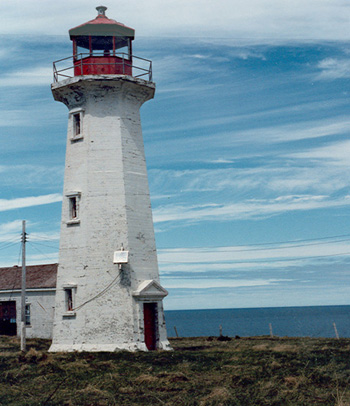Light Tower
Recognized Federal Heritage Building
Cap-de-la-Table, Quebec

Exterior view
© Transport Canada / Transports Canada
Address :
Île-Anticosti, Cap-de-la-Table, Quebec
Recognition Statute:
Treasury Board Policy on Management of Real Property
Designation Date:
1990-11-02
Dates:
-
1917 to 1918
(Construction)
Event, Person, Organization:
-
Department of Marine and Fisheries
(Architect)
Custodian:
Fisheries and Oceans Canada
FHBRO Report Reference:
89-185
DFRP Number:
08024 00
Description of Historic Place
The Light Tower is located at Cap de la Table on the north coast of Anticosti Island in the Gulf of the St. Lawrence. It is a tapered, octagonal, white concrete structure with a flared cornice and a red-painted, multi-sided lantern. The tower’s main decorative features are the pedimented cap over the doorway and the triangular lintels over the vertically aligned windows. The designation is confined to the footprint of the building.
Heritage Value
The Light Tower is a Recognized Federal Heritage Building because of its historical associations, and its architectural and environmental value.
Historical Value
The Light Tower is closely associated with improving aids to navigation in the Gulf of the St. Lawrence. The lighting of the north coast of Anticosti Island helped improve maritime transportation by making the passage safer for vessels taking the shorter route from the Strait of Belle Isle to the mouth of the St. Lawrence River. Until the establishment of these lights, and one at Petite-Ile-au-Marteau in 1915, navigation in the Jacques Cartier Strait had been confined largely to the local fishing fleet and ships coming to supply local residents.
Architectural Value
The Light Tower is valued for its good aesthetic qualities and functional design. It was one of a number of octagonal, reinforced concrete structures built by the Department of Marine and Fisheries during the early years of the 20th century. Built with good craftsmanship and materials, it is well-suited to the constraints of its function and of the site. The triangular lintels over the windows lighten the building’s austere appearance.
Environmental Value
The Light Tower reinforces the maritime character of its coastal island setting and is a familiar landmark in for all mariners and fishermen in the area.
Sources: Margaret Coleman, Lighttower, Cap de la Table (Table Head), Anticosti Island, Québec, Federal Heritage Buildings Review Office, Building Report, 89-185; Lighttower, Cap de la Table, Anticosti Island, Québec, Heritage Character Statement, 89-185.
Character-Defining Elements
The character-defining elements of the Light Tower should be respected.
Its good aesthetic and functional design and good craftsmanship and materials, for example: the simple massing, which consists of a white concrete, octagonal tapered tower with a flared cornice; the reinforced concrete construction; the pedimented cap over the doorway and the triangular lintels over the windows; the red-painted gallery guardrail and the red-painted, multi-sided, metal lantern.
The manner in which the Light Tower reinforces the maritime character of its coastal setting and is a familiar landmark in the area, as evidenced by: its overall scale, massing, design and materials, making it an integral part of the maritime setting; its high visibility and its role as a marker of its coastal environment.
Heritage Character Statement
Disclaimer -
The heritage character statement was developed by FHBRO to explain the reasons for the designation of a federal heritage building and what it is about the building that makes it significant (the heritage character). It is a key reference document for anyone involved in planning interventions to federal heritage buildings and is used by FHBRO in their review of interventions.
The lighttower at Cap de la Table is located near the east end of the north coast of Anticosti Island in the Gulf of St. Lawrence. It was built in 1917-1918 by the Department of Marine and Fisheries. The station initially included a double dwelling, which was demolished in 1959-60 and replaced by two separate residences. Although a new fog alarm building was built in 1956, the old one is still in place. The lighttower is now managed by the Canadian Coast Guard. See FHBRO Report 89-185.
Reasons For Designation
The lighttower at Cap de la Table was designated Recognized for historical and environmental reasons.
The lighting of the north coast of the island helped improve maritime transportation by making the passage of vessels taking the shorter route from the Strait of Belle Isle to the mouth of the St. Lawrence River safer.
Since its construction, the lighttower has been a landmark for all mariners and fishermen. It forms an integral part of the maritime landscape of the island.
Character defining elements
The heritage value of the lighttower derives from its method of construction and its strategic location for navigation in Jacques Cartier Strait.
This octagonal reinforced concrete tower is 40 feet in height, base to vane. Built in the style developed in the early part of the century, it is well suited to the constraints of its function and of the site. The pedimented cap over the doorway and the triangular lintels over the windows are decorative elements which lighten the building's austerity.
In order to ensure the preservation of this interesting structure, a restoration program should be implemented as soon as possible. Any work on the historic concrete must be done under the direction of a conservation specialist. Together with the neighbouring buildings, the lighttower forms a coherent whole. Every effort should be made to conserve this historic feature of our maritime landscape.